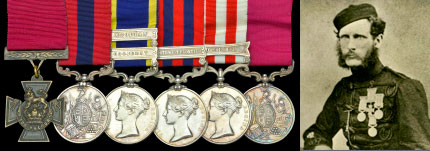One of the first Victoria Crosses ever won by an Irishman will be auctioned in London on Friday next (September 19th 2014) by medal auctioneers and valuers DNW (Dix Noonan Webb) of Bolton St, Mayfair, London. The VC for auction, the British Army’s highest honour for bravery, was awarded to the Cashel, Co Tipperary, born Stephen Garvin in 1857, during the Indian Mutiny, latter a 19th-century rebellion against British rule in India.
The Victoria Cross medal is the highest military honour to be awarded in the world and a medal which has always been awarded regardless of an individuals class, religious creed or colour. Indeed when Queen Victoria first instituted the Victoria Cross first in 1856 she essentially wanted it to be an award “Trifling in intrinsic value, but shall be highly prized and eagerly sought after.” This small medal, often referred to as “The little Cross of Bronze,” manufactured from the bronze of two Russian cannon captured at Sevastopol during the Crimean War, soon was to become the world’s most prized gallantry award.

Stephen Garvin VC, Cashel, Co Tipperary
Stephen Garvin was born in Cashel here in County Tipperary, Ireland, in 1826 and originally enlisted in the 74th Regiment first in 1842. Later he transferring to the 60th Rifles, seeing action in the Punjab campaign of 1848-49 and in operations on the North-West Frontier in 1849-50. He was serving in India when the Mutiny broke out in 1857 and was one of those men of the 60th who found the mutilated bodies of two comrades and the corpse of a popular Englishwoman, all of whom who had been killed by the mutineers.
A Colour-Sergeant in the 60th Rifles, Stephen Garvin was regarded as one of the great heroes of Victorian Britain, also winning the Distinguished Conduct Medal and was the most highly decorated non-commissioned soldier to emerge from this conflict. He was personally presented with the VC at an investiture in Windsor Home Park by Queen Victoria herself, when he returned to England in 1860.
Garvin was awarded his Victoria Cross following a deed which took place on 23rd June 1857 at Delhi, India.
His citation reads; “For daring and gallant conduct before Delhi on the 23rd of June, 1857, in volunteering to lead a small party of men, under a heavy fire, to the ” Sammy House,” for the purpose of dislodging a number of the Enemy in position there, who kept up a destructive fire on the advanced battery of heavy guns, in which, after a sharp contest, he succeeded.”
Stephen Garvin left the army in 1865 and was later appointed a Yeoman of the Guard. He moved to Cambridge, where he died in 1874 aged 48, just months after the deaths of his second wife Mary and baby daughter Sophia. The three of them remain buried together in St Andrew’s Churchyard, Chesterton, Cambridge.
The London sale of Stephen Garvin’s six medals, brought to the market by a private collector, are expected to reach a possible sale price of some €175,000.
Of course Stephen Garvin was not the only Tipperary VC winner present in India at this time. William Bradshaw VC (12th February 1830 – 9th March 1861), born here in Thurles, County Tipperary, was also an Irish recipient of the Victoria Cross. He served during the Crimean War in the 50th Regiment of Foot, transferring latter to the 90th Regiment of Foot.
William Bradshaw VC, Thurles, Co Tipperary
William Bradshaw was 27 years old and an assistant surgeon in the 90th Regiment (later known as ‘The Cameroonians’ (Scottish Rifles)), of the British Army during the Indian Mutiny when the following deed took place at Lucknow, India, and for which he himself was awarded the VC.
Assistant-Surgeon William Bradshaw carried out his act of bravery on 26th September, 1857.
His citation reads; “For intrepidity and good conduct when, ordered with Surgeon Home, 90th Regiment, to remove the wounded men left behind the column that forced its way into the Residency of Lucknow, on the 26th September, 1857. The dooly (A light litter (stretcher) suspended from men’s shoulders, for the carrying of persons.) bearers had left the doolies, but by great exertions and notwithstanding the close proximity of the sepoys (Private Soldier), Surgeon Home, and Assistant-Surgeon Bradshaw got some of the bearers together and Assistant-Surgeon Bradshaw with about twenty doolies, becoming separated from the rest of the party, succeeded in reaching the Residency in safety by the river bank.”
William Bradshaw died on March 9th 1861 and is buried in St Mary’s Church graveyard, here in Thurles, with a memorial to be found within the church itself. His Victoria Cross is displayed at the Army Medical Services Museum in Aldershot, Hampshire England.
In all 30 Irish Victoria Crosses (VC) were awarded during the Crimean War with 59 Irish VC’s awarded during the Indian Mutiny. Some 46 Irish VC’s were awarded in numerous other British Empire campaigns between the years 1857 to 1914 followed by 37 Irish VC’s awarded during World War I and eight Irish VC’s awarded during World War II. Latter therefore represents a very large number of VC’s being awarded to Irish military born personnel, especially when you understand that in the 158 years since it was first instituted, only 1356 VC’s are understood to have ever been awarded in total.

Leave a Reply